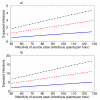Calculating the potential for within-flight transmission of influenza A (H1N1)
- PMID: 20034378
- PMCID: PMC2813231
- DOI: 10.1186/1741-7015-7-81
Calculating the potential for within-flight transmission of influenza A (H1N1)
Abstract
Background: Clearly air travel, by transporting infectious individuals from one geographic location to another, significantly affects the rate of spread of influenza A (H1N1). However, the possibility of within-flight transmission of H1N1 has not been evaluated; although it is known that smallpox, measles, tuberculosis, SARS and seasonal influenza can be transmitted during commercial flights. Here we present the first quantitative risk assessment to assess the potential for within-flight transmission of H1N1.
Methods: We model airborne transmission of infectious viral particles of H1N1 within a Boeing 747 using methodology from the field of quantitative microbial risk assessment.
Results: The risk of catching H1N1 will essentially be confined to passengers travelling in the same cabin as the source case. Not surprisingly, we find that the longer the flight the greater the number of infections that can be expected. We calculate that H1N1, even during long flights, poses a low to moderate within-flight transmission risk if the source case travels First Class. Specifically, 0-1 infections could occur during a 5 hour flight, 1-3 during an 11 hour flight and 2-5 during a 17 hour flight. However, within-flight transmission could be significant, particularly during long flights, if the source case travels in Economy Class. Specifically, two to five infections could occur during a 5 hour flight, 5-10 during an 11 hour flight and 7-17 during a 17 hour flight. If the aircraft is only partially loaded, under certain conditions more infections could occur in First Class than in Economy Class. During a 17 hour flight, a greater number of infections would occur in First Class than in Economy if the First Class Cabin is fully occupied, but Economy class is less than 30% full.
Conclusions: Our results provide insights into the potential utility of air travel restrictions on controlling influenza pandemics in the winter of 2009/2010. They show travel by one infectious individual, rather than causing a single outbreak of H1N1, could cause several simultaneous outbreaks. These results imply that, during a pandemic, quarantining passengers who travel in Economy on long-haul flights could potentially be an important control strategy. Notably, our results show that quarantining passengers who travel First Class would be unlikely to be an effective control strategy.
Figures


References
-
- Novel Swine-Origin Influenza A (H1N1) Investigation Team. Dawood FS, Jain S, Finelli L, Shaw M, Lindstrom S, Garten RJ, Gubareva LV, Bridges CB, Uyeki TM. Emergence of a novel swine-origin influenza A (H1N1) virus in humans. N Engl J Med. 2009;25:2605–2615. doi: 10.1056/NEJMoa0903810. - DOI - PubMed
Publication types
MeSH terms
LinkOut - more resources
Full Text Sources
Medical
Miscellaneous

